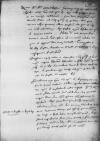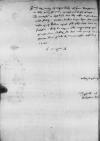List #2442
Sigmund von HERBERSTEIN do Ioannes DANTISCUSVienna, 1541-06-25
| odebrano Heilsberg (Lidzbark Warmiński), 1541-07-25 Rękopiśmienne podstawy źródłowe:
Pomocnicze podstawy źródłowe:
Publikacje:
| ||||||||||||
Tekst + aparat krytyczny + komentarzZwykły tekstTekst + komentarzTekst + aparat krytyczny
 AAWO, AB, D. 6, f. 1v unnumbered after f. 42
AAWO, AB, D. 6, f. 1v unnumbered after f. 42
Reverendissimo Domino, domino
Reverendissime Domine, domine observandissime. Servitiorum meorum praemissa commendatione.
Hodie accepi cf.
Scripseram equidem antea et cupivissem Vestram Reverendissimam Dominationem huic magno negotio Christanitatis destinatam[4]. Et hodie cuperem quomodocumque, et si illustrissimus dominus
Humillimas ago ms. agro(!)
⌈agoago ms. agro(!)
⌉ gratias Vestrae Reverendissimae Dominationi de participatis novis, quae in
Serenissimus rex meus quinque diebus abhinc
Ex
Eiusdem Vestrae Reverendissimae Dominationis obsequentissimus
[1] See cf.
[2] Letter not known to the editors.
[3] Cf. cf.
[4] Cf. cf.
[5] In February 1541 Andrzej Górka, as an envoy of Sigismund I, went to Vienna to undertake mediation between Ferdinand I and Isabella Zápolya, widow of János I Zápolya. Isabella and her son János II Sigismund Zápolya (see letter No.32, footnote 25), not yet a year old but already pronounced his father’s successor and recognized as such by Suleiman I, were in Buda which was under siege from Ferdinand I’s forces (see footnote 12). Górka went on two missions to the camp of the besieging forces, and from there to Buda itself to persuade Isabella to accept Ferdinand I’s terms and surrender the city. These activities of Górka are most likely the subject of Herberstein’s remarks in this letter. During the second stage of the negotiations in May, Isabella was inclined to surrender but George Utješenović (Martinuzzi; Frater Georgius) was against this, and Górka left Buda without achieving his objective. In September, under orders from Sigismund I, he negotiated Isabella’s future with Suleiman I (see cf. Anna Dembińska, Zygmunt I. Zarys dziejów wewnętrzno - politycznych w latach 1540-1548, Poznań, Państwowe Zakłady Wydawnictw Szkolnych, 1948, series: Poznańskie TPN Prace Komisji Historycznej 15/3 ⌊DEMBIŃSKA 1948cf. Anna Dembińska, Zygmunt I. Zarys dziejów wewnętrzno - politycznych w latach 1540-1548, Poznań, Państwowe Zakłady Wydawnictw Szkolnych, 1948, series: Poznańskie TPN Prace Komisji Historycznej 15/3 ⌋, p. 198, footnote 4; cf. Andrzej Dziubiński, Stosunki dyplomatyczne polsko-tureckie w latach 1500-1572 w kontekście międzynarodowym, Wrocław, Fundacja na rzecz Nauki Polskiej, 2005 ⌊DZIUBIŃSKIcf. Andrzej Dziubiński, Stosunki dyplomatyczne polsko-tureckie w latach 1500-1572 w kontekście międzynarodowym, Wrocław, Fundacja na rzecz Nauki Polskiej, 2005 ⌋, p. 133-134, 137, 143-146; cf. Fodor Pál, "Ottoman Policy Towards Hungary, 1520-1541", in: Acta Orientalia Academiae Scientiarum Hungaricae XLV (2-3), 1991, p. 271-245 ⌊PÁLcf. Fodor Pál, "Ottoman Policy Towards Hungary, 1520-1541", in: Acta Orientalia Academiae Scientiarum Hungaricae XLV (2-3), 1991, p. 271-245 ⌋, p. 305, 313, cf. cf. Elementa ad fontium editiones 36. Res Polonicae ex Archivo Regiomontano, VI pars (AD. 1538-1542), vol. 36, ed. by Karolina Lanckorońska, Roma, 1975 ⌊EFE 36cf. Elementa ad fontium editiones 36. Res Polonicae ex Archivo Regiomontano, VI pars (AD. 1538-1542), vol. 36, ed. by Karolina Lanckorońska, Roma, 1975 ⌋, No. 672, p. 109, No. 699, p. 149-150, No. 700, p. 151-153, No. 706, p. 163-164 (Annexum II), No. 710, p. 169).
[6] Agit et prudenter agit – this is most likely a reference to the saying: Quidquid agas, prudenter agas et respice finem (see Gest. Rom., cap. 162).
[7] Cf. cf.
[8] The forces of Ferdinand I laying siege to Buda, about 20,000 strong, were under Wilhelm von Rogendorf’s command. The siege ended on August 21, 1541 with the defeat and hasty evacuation of Ferdinand I’s forces, followed by Buda’s capture by Suleiman I (cf. Gratae posteritati Sigismundus liber baro in Herberstein Neyperg et Guettenhag, primarius ducatus Carinthiae hereditariusque et camerarius … actiones suas a puero ad annum usque aetatis suae septuagesimum quartum brevi commentariolo notatas reliquit, Vienna, Raphael Hofhalter, 1560 ⌊HERBERSTEIN 1560cf. Gratae posteritati Sigismundus liber baro in Herberstein Neyperg et Guettenhag, primarius ducatus Carinthiae hereditariusque et camerarius … actiones suas a puero ad annum usque aetatis suae septuagesimum quartum brevi commentariolo notatas reliquit, Vienna, Raphael Hofhalter, 1560 ⌋, f. D4r-D4v; cf. Elementa ad fontium editiones 36. Res Polonicae ex Archivo Regiomontano, VI pars (AD. 1538-1542), vol. 36, ed. by Karolina Lanckorońska, Roma, 1975 ⌊EFE 36cf. Elementa ad fontium editiones 36. Res Polonicae ex Archivo Regiomontano, VI pars (AD. 1538-1542), vol. 36, ed. by Karolina Lanckorońska, Roma, 1975 ⌋, No. 694, p. 145-146, No. 696, p. 147, No. 699, p. 148-150, No. 700, p. 151-153, No. 702, p. 155, No. 706, p. 157-166; cf. Andrzej Dziubiński, Stosunki dyplomatyczne polsko-tureckie w latach 1500-1572 w kontekście międzynarodowym, Wrocław, Fundacja na rzecz Nauki Polskiej, 2005 ⌊DZIUBIŃSKIcf. Andrzej Dziubiński, Stosunki dyplomatyczne polsko-tureckie w latach 1500-1572 w kontekście międzynarodowym, Wrocław, Fundacja na rzecz Nauki Polskiej, 2005 ⌋, p. 142-143; cf. Paula Sutter Fichtner, Ferdinand I of Austria: The Politics of Dynasticism in the Age of Reformation, New York, 1982 ⌊Fichtnercf. Paula Sutter Fichtner, Ferdinand I of Austria: The Politics of Dynasticism in the Age of Reformation, New York, 1982 ⌋, p. 125; cf. Joseph von Hammer-Purgstall, Vom Regierungsantritte Suleiman des Ersten bis zum Tode Selim's II. 1520-1574, vol. III, Pest, 1828, series: Geschichte des Osmanischen Reiches, grossentheils aus bisher unbenützten Handschriften und Archiven ⌊Hammer-Purgstall IIIcf. Joseph von Hammer-Purgstall, Vom Regierungsantritte Suleiman des Ersten bis zum Tode Selim's II. 1520-1574, vol. III, Pest, 1828, series: Geschichte des Osmanischen Reiches, grossentheils aus bisher unbenützten Handschriften und Archiven ⌋, p. 224-234; cf. cf.
[9] The Sublime Porte, High Porte – the name used pars pro toto until the mid-17th century to denote the sultan’s palace and also his court. It refers to the gate (Lat. porta) of the Topkapı palace in Constantinople and is linked to its significance in traditional culture: as a symbolic border between the sacrum of the monarch’s residence and the profanum of the world, and as a symbol of the sultan’s justice, as the gate leading to the residence was the equivalent of the entrance to the tent in front of which early rulers meted out justice.
[10] Mehmed Pasha, together with Hüsrev Pasha, the beylerbey of Rumelia, commanded the Turkish army corps marching on Hungary (cf. Andrzej Dziubiński, Stosunki dyplomatyczne polsko-tureckie w latach 1500-1572 w kontekście międzynarodowym, Wrocław, Fundacja na rzecz Nauki Polskiej, 2005 ⌊DZIUBIŃSKIcf. Andrzej Dziubiński, Stosunki dyplomatyczne polsko-tureckie w latach 1500-1572 w kontekście międzynarodowym, Wrocław, Fundacja na rzecz Nauki Polskiej, 2005 ⌋, p. 142, 144, 154, cf. cf. Elementa ad fontium editiones 36. Res Polonicae ex Archivo Regiomontano, VI pars (AD. 1538-1542), vol. 36, ed. by Karolina Lanckorońska, Roma, 1975 ⌊EFE 36cf. Elementa ad fontium editiones 36. Res Polonicae ex Archivo Regiomontano, VI pars (AD. 1538-1542), vol. 36, ed. by Karolina Lanckorońska, Roma, 1975 ⌋, No. 694, p. 145).
[11] In 1541 Hüsrev Pasha was the beylerbey of Rumelia (Romania). In February or early March 1541, the sultan sent him to Sofia with 1,500 Janissaries and 1,800 court Sipahis, to reinforce the Turkish army spending the winter in Hungary and prepare the campaign in which the sultan himself was to take part (cf. Andrzej Dziubiński, Stosunki dyplomatyczne polsko-tureckie w latach 1500-1572 w kontekście międzynarodowym, Wrocław, Fundacja na rzecz Nauki Polskiej, 2005 ⌊DZIUBIŃSKIcf. Andrzej Dziubiński, Stosunki dyplomatyczne polsko-tureckie w latach 1500-1572 w kontekście międzynarodowym, Wrocław, Fundacja na rzecz Nauki Polskiej, 2005 ⌋, p. 142, 144; cf. Fodor Pál, "Ottoman Policy Towards Hungary, 1520-1541", in: Acta Orientalia Academiae Scientiarum Hungaricae XLV (2-3), 1991, p. 271-245 ⌊PÁLcf. Fodor Pál, "Ottoman Policy Towards Hungary, 1520-1541", in: Acta Orientalia Academiae Scientiarum Hungaricae XLV (2-3), 1991, p. 271-245 ⌋, p. 311).
[12] Suleiman I set off from Constantinople with the main army on June 23, 1541 and was in Belgrade in early August, from where he set off for Buda, entering it on September 2 (see cf. Andrzej Dziubiński, Stosunki dyplomatyczne polsko-tureckie w latach 1500-1572 w kontekście międzynarodowym, Wrocław, Fundacja na rzecz Nauki Polskiej, 2005 ⌊DZIUBIŃSKIcf. Andrzej Dziubiński, Stosunki dyplomatyczne polsko-tureckie w latach 1500-1572 w kontekście międzynarodowym, Wrocław, Fundacja na rzecz Nauki Polskiej, 2005 ⌋, p. 142; cf. Joseph von Hammer-Purgstall, Vom Regierungsantritte Suleiman des Ersten bis zum Tode Selim's II. 1520-1574, vol. III, Pest, 1828, series: Geschichte des Osmanischen Reiches, grossentheils aus bisher unbenützten Handschriften und Archiven ⌊Hammer-Purgstall IIIcf. Joseph von Hammer-Purgstall, Vom Regierungsantritte Suleiman des Ersten bis zum Tode Selim's II. 1520-1574, vol. III, Pest, 1828, series: Geschichte des Osmanischen Reiches, grossentheils aus bisher unbenützten Handschriften und Archiven ⌋, p. 232-233).
[13] The rumor that Herberstein mentions here, that Suleiman I is dead, was untrue.
[14] In spring 1541, Ferdinand I was still convinced that Suleiman I would not decide to begin the campaign. It was not until he received a report from Venice dated June 18 that he realized how serious the situation was. On June 25, 1541 he presented the matter of the Turkish threat to the estates of the Reich gathered at the diet in Regensburg, appealing for military help. The Catholics agreed to give him 10,000 armed soldiers and 3,000 horses, while the Protestants put off their decision until the end of July (cf. Paul Heidrich, Karl V. und die deutschen Protestanten am Vorabend des Schmalkaldischen Krieges, Frankfurt a. M., 1911, part 1: Die Reichstage der Jahre 1541-1543, Auf Grund vornemhlich der Reichstage dargestellt ⌊HEIDRICH 1911cf. Paul Heidrich, Karl V. und die deutschen Protestanten am Vorabend des Schmalkaldischen Krieges, Frankfurt a. M., 1911, part 1: Die Reichstage der Jahre 1541-1543, Auf Grund vornemhlich der Reichstage dargestellt ⌋, p. 11-53; cf. Paula Sutter Fichtner, Ferdinand I of Austria: The Politics of Dynasticism in the Age of Reformation, New York, 1982 ⌊Fichtnercf. Paula Sutter Fichtner, Ferdinand I of Austria: The Politics of Dynasticism in the Age of Reformation, New York, 1982 ⌋, p. 125; cf. Fodor Pál, "Ottoman Policy Towards Hungary, 1520-1541", in: Acta Orientalia Academiae Scientiarum Hungaricae XLV (2-3), 1991, p. 271-245 ⌊PÁLcf. Fodor Pál, "Ottoman Policy Towards Hungary, 1520-1541", in: Acta Orientalia Academiae Scientiarum Hungaricae XLV (2-3), 1991, p. 271-245 ⌋, p. 313, cf. cf. Elementa ad fontium editiones 36. Res Polonicae ex Archivo Regiomontano, VI pars (AD. 1538-1542), vol. 36, ed. by Karolina Lanckorońska, Roma, 1975 ⌊EFE 36cf. Elementa ad fontium editiones 36. Res Polonicae ex Archivo Regiomontano, VI pars (AD. 1538-1542), vol. 36, ed. by Karolina Lanckorońska, Roma, 1975 ⌋, No. 699, p. 149, cf. No. 700, p. 152-153, cf. Elementa ad fontium editiones 48. Res Polonicae ex Archivo Regiomontano, XVIII pars (AD. 1539-1541), vol. 48, ed. by Karolina Lanckorońska, Roma, 1979 ⌊EFE 48cf. Elementa ad fontium editiones 48. Res Polonicae ex Archivo Regiomontano, XVIII pars (AD. 1539-1541), vol. 48, ed. by Karolina Lanckorońska, Roma, 1979 ⌋, No. 411, p. 202 and Annexum II, p. 203; cf. Johannes Voigt, "Briefwechsel des Freih. Sigismund von Herberstein mit dem Herzog Albrecht von Preußen", in: Archiv zur Kunde österreichische Geschichtes-Quellen vol. 17/2, Wien, 1857, p. 265-293 ⌊VOIGT 1857cf. Johannes Voigt, "Briefwechsel des Freih. Sigismund von Herberstein mit dem Herzog Albrecht von Preußen", in: Archiv zur Kunde österreichische Geschichtes-Quellen vol. 17/2, Wien, 1857, p. 265-293 ⌋, p. 283).
[15] Cf. cf.
[16] A reference to the great fire that broke out on June 2 in Prague in Malá Strana. It spread to Hradčany and seriously damaged the royal castle with the archive of so-called zemské desky (land tablets, i.e. volumes – basic records concerning land property of the Czech nobility) and the Cathedral of Saints Vitus, Wenceslas and Adalbert (see e.g. cf. Monarchie und Wiederstand. Zur ständischen Oppositionsbildung im Herrschaftssystem Ferdinands I. in Böhmen, München, 1985 ⌊Eberhardcf. Monarchie und Wiederstand. Zur ständischen Oppositionsbildung im Herrschaftssystem Ferdinands I. in Böhmen, München, 1985 ⌋, p. 345; cf. Jörg Hoensch, Geschichte Böhemens. Von der slavischen Landnahme bis ins 20. Jahrhundert, München, 1987 ⌊Hoenschcf. Jörg Hoensch, Geschichte Böhemens. Von der slavischen Landnahme bis ins 20. Jahrhundert, München, 1987 ⌋, p. 191).


